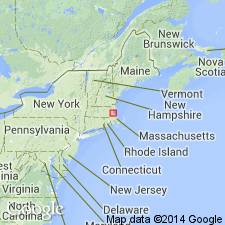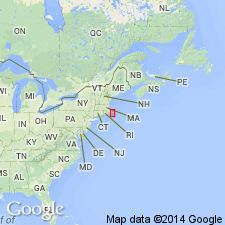
- Usage in publication:
-
- Brighton Melaphyre
- Modifications:
-
- Not used
- AAPG geologic province:
-
- New England province
Summary:
Brighton Melaphyre is not shown on map. [Instead, a unit listed as "Melaphyre in the Roxbury Conglomerate" apparently represents rocks of Brighton Melaphyre.] The other two formations in Boston Bay Group, Cambridge Argillite and Roxbury Conglomerate, are shown, but the assignment to Boston Bay Group is not used.
Source: GNU records (USGS DDS-6; Reston GNULEX).

- Usage in publication:
-
- Brighton Volcanics
- Modifications:
-
- Overview
- Dominant lithology:
-
- Basalt
- Andesite
- AAPG geologic province:
-
- New England province
Summary:
Middlesex Fells Volcanic Complex preceded the emplacement of the Dedham Granite and the Lynn Volcanics, while the Brighton Volcanics of the Boston Bay Group postdate them. The sedimentary rocks of the Boston Bay, with which the Brighton Volcanics are interlayered, contain clasts of the Mattapan Volcanics (602+/-3 Ma) and therefore are younger. Brighton described as mafic to intermediate flows, tuffs, and pillow lavas that include volcanic breccias, coarse pyroclastics, and agglomerates. The high alumina basalts, basaltic andesites, and andesites of the Brighton are metamorphosed to lowermost greenschist facies. Geochemical evidence suggests a subduction-zone environment.
Source: GNU records (USGS DDS-6; Reston GNULEX).

- Usage in publication:
-
- Brighton Melaphyre*
- Modifications:
-
- Overview
- AAPG geologic province:
-
- New England province
Summary:
Brighton Melaphyre of Boston Bay Group occurs within Roxbury Conglomerate, the lowermost of the Boston Bay units. Consists of dark-gray to dark-greenish-gray and reddish-gray quartz keratophyre, keratophyre, and spilite. Spilites form flows, pillow lavas, feeder pipes and vents, and pyroclastic rocks. Keratophyres form massive flows, breccias, pillow lavas, and laminated devitrified palagonite tuff. Altered mafic dikes within Mattapan Volcanic Complex (which underlies Roxbury Conglomerate) are considered part of Brighton Melaphyre. Some of the Brighton may be contemporaneous with Mattapan. Age is Proterozoic Z and possibly Early Cambrian. Report contains geologic maps and correlation charts. [Chapters A-J in U.S. Geological Survey Professional Paper 1366 are intended as explanations and (or) revisions to 1:250,000-scale MA State bedrock geologic map of Zen and others (1983).]
Source: GNU records (USGS DDS-6; Reston GNULEX).
For more information, please contact Nancy Stamm, Geologic Names Committee Secretary.
Asterisk (*) indicates published by U.S. Geological Survey authors.
"No current usage" (†) implies that a name has been abandoned or has fallen into disuse. Former usage and, if known, replacement name given in parentheses ( ).
Slash (/) indicates name conflicts with nomenclatural guidelines (CSN, 1933; ACSN, 1961, 1970; NACSN, 1983, 2005, 2021). May be explained within brackets ([ ]).

